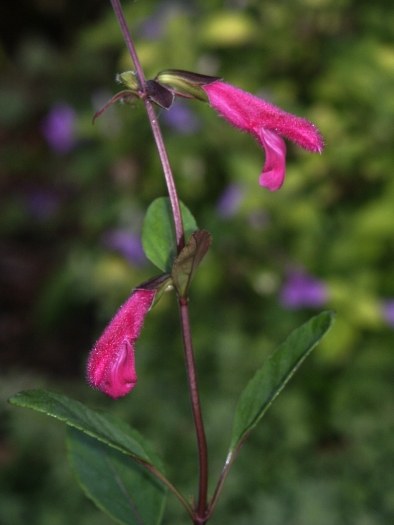Buchanan’s Sage
(Salvia buchananii)
Buchanan’s Sage (Salvia buchananii)
/
/

Scott Zona
CC BY 2.0
Image By:
Scott Zona
Recorded By:
Copyright:
CC BY 2.0
Copyright Notice:
Photo by: Scott Zona | License Type: CC BY 2.0 | License URL: https://creativecommons.org/licenses/by/2.0 | Uploader: Pixeltoo | Publisher: Wikimedia Commons | Title: Salvia_buchananii_(Scott_Zona)_001.jpg | Notes: {{Information |Description={{en|1=''[[Salvia dolomitica]]'' Botanical Gardens in Encinitas, California, USA. Identified by sign.}} |Source=Own work by uploader |Author=[[User:Stickpen|Stickpen]] |Date=April 14, 2009 |Permission=released to public |


Estimated Native Range
Summary
Salvia buchananii, commonly known as Buchanan’s Sage, is a deciduous herb or subshrub, originally native to the cloud forests, pine-oak forests, and oak thickets of Northeast Mexico, particularly in Querétaro. Although it is thought to be extinct in the wild, it continues to thrive in cultivation. This herbaceous perennial typically grows to a height of 1–2 feet and spreads about 1 foot wide. It features glossy green leaves that are widely spaced along the stem, contributing to its airy appearance. The plant is renowned for its vibrant magenta flowers, which are about two inches long and bloom in the summer. Despite their beauty, these flowers rarely set seed. Buchanan’s Sage is celebrated for its striking floral display and is a recipient of the Royal Horticultural Society’s Award of Garden Merit.
In the garden, Buchanan’s Sage is valued for its bright flowers and relatively low maintenance requirements. It is often used in borders, as part of a perennial bed, or in containers. This sage prefers full sun to part shade and requires medium amounts of water, along with well-draining soil. While it is easy to propagate from cuttings, gardeners must protect it from frost and cold wet winters, as it does not tolerate such conditions. It is particularly well-suited to temperate climates.CC BY-SA 4.0
In the garden, Buchanan’s Sage is valued for its bright flowers and relatively low maintenance requirements. It is often used in borders, as part of a perennial bed, or in containers. This sage prefers full sun to part shade and requires medium amounts of water, along with well-draining soil. While it is easy to propagate from cuttings, gardeners must protect it from frost and cold wet winters, as it does not tolerate such conditions. It is particularly well-suited to temperate climates.CC BY-SA 4.0
Plant Description
- Plant Type: Herb
- Height: 1-2 feet
- Width: 0.5-1 feet
- Growth Rate: Moderate
- Flower Color: Pink
- Flowering Season: Fall
- Leaf Retention: Deciduous
Growth Requirements
- Sun: Full Sun, Part Shade
- Water: Medium
- Drainage: Medium
Common Uses
Bee Garden, Bird Garden, Border Plant, Butterfly Garden, Deer Resistant, Drought Tolerant, Fragrant, Hummingbird Garden, Low Maintenance, Potted Plant, Rabbit Resistant, Showy Flowers
Natural Habitat
Originally native to the cloud forests, pine-oak forests, and oak thickets of Northeast Mexico
Other Names
Common Names:
Scientific Names: Salvia buchananii
GBIF Accepted Name: Salvia buchananii Hedge